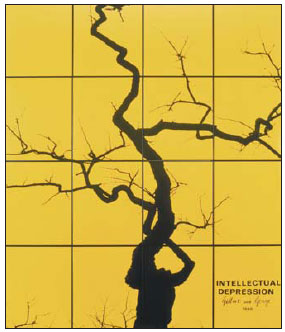Society
Touch of contemporary Britain in ancient Xi'an
Updated: 2011-03-17 07:58
By Chen Jie (China Daily)
|
Intellectual Depression, mixed media, by Gilbert & George in 1980, on display at Xi'an Art Museum. Provided to China Daily |
Think of Xi'an and what first comes to mind is a city with a history of more than 3,000 years that served as the capital for 13 dynasties, or more than 1,200 years; a city of the terracotta warriors of Emperor Qin Shihuang's mausoleum and of a 600-year-old city wall.
But today's Xi'an is also a city with a highly developed industrial base, besides being a renowned center of technological innovation in Asia.
Qujiang new district, in the city's southeastern part, exemplifies this mix of old and new. Dominated today by the culture and tourism industries, it was "a hunting area in ancient times and when I was a kid, it was just wasteland", says 41-year-old Xi'an-born artist and curator Shu Yang.
Earlier this month, Shu co-curated an exhibition of British contemporary art that opened at Xi'an Art Museum, in Qujiang new district, and will run till April 10.
Entitled Made in Britain: Contemporary Art from the British Council Collection 1980-2010, the exhibition showcases more than 160 works by some 40 prominent artists in the past three decades, and includes paintings, sculptures, installations, videos, photographs, and prints.
The exhibition is a follow-up of The Future Demands Your Participation exhibition which was held in Shanghai in 2010 as part of the United Kingdom's program of cultural events for the Shanghai Expo.
"Our exhibition in Shanghai was well-received by Chinese audiences and we wanted to bring British contemporary art to more audiences and ensure that the legacy of the UK's participation in Shanghai Expo is shared by people across China," says Joanna Burke, cultural counselor, British Embassy, Beijing.
"Xi'an is a good place to hold the exhibition," she adds. "The city has a rich culture and long history, but it's not only known for its past and traditional culture. It's also expanding. We were very keen that the exhibition should not go to Beijing and Shanghai."
Shu shares her view and believes Xi'an is a natural museum for the display of "controversial and challenging art". The artist who learned painting at the Xi'an Academy of Fine Arts was once proud of the "Chang'an school of painting", a group of artists based in Xi'an in the 1960s famous for painting the loess plateau and the villagers in Shaanxi province, but is now an ardent fan of contemporary art from both home and abroad.
"To many Chinese people, British culture means Shakespeare's plays, Hitchcock's movies, Beatles' oldies and Manchester United. But one other great achievement that cannot be overlooked is British contemporary art," he says.
"When I was invited to see the British Council's collection in London to prepare for this exhibition tour in China, I was amazed to see not only the masterpieces by world famous artists, like Henry Moore, Lucian Freud, and Damien Hirst but many iconic works created by these artists in the early stages of their career.
"These are rarely seen in China."
A crucial part of the development of British contemporary art is the emergence of YBA (Young British Artists) in the late 1980s and early 1990s. "Fresh from art school, these young artists boldly challenged the traditional approach to art. They experimented with different media and materials, and their works were imbued with a powerful individuality," Shu says.
"Rich in social, cultural and political elements, their works were often controversial. Some scholars remarked that their emergence signified the birth of a new British culture and social landscape. Their influence grew over time and today YBA is a famous name," says Andrea Rose, Director of Visual Arts, British Council.
The touring exhibition in China includes works by iconic YBA artists including Damien Hirst, Mark Wallinger and Sarah Lucas. The exhibition has already been to Chengdu and will move from Xi'an to Hong Kong Heritage Museum from June 29 to Oct 9, and to Suzhou Museum from Oct 20 to Jan 12, 2012.
Specials

'Super moon'
The "Super Moon" arrives at its closest point to the Earth in 2011.

Radiation test
The probability of being exposed to a life-threatening level of radiation is quite slim.

Panic buying of salt
Worried Chinese shoppers stripped stores of salt on radiation fears.
